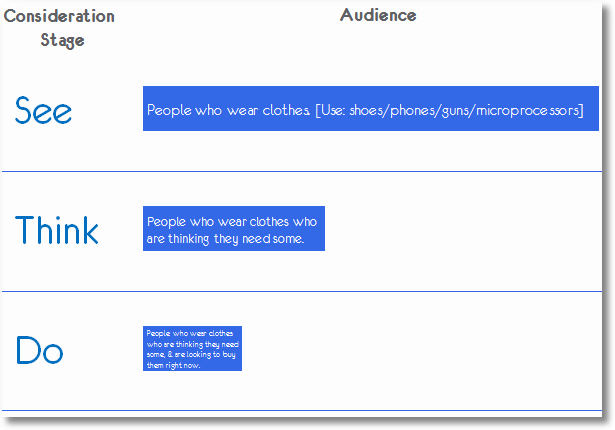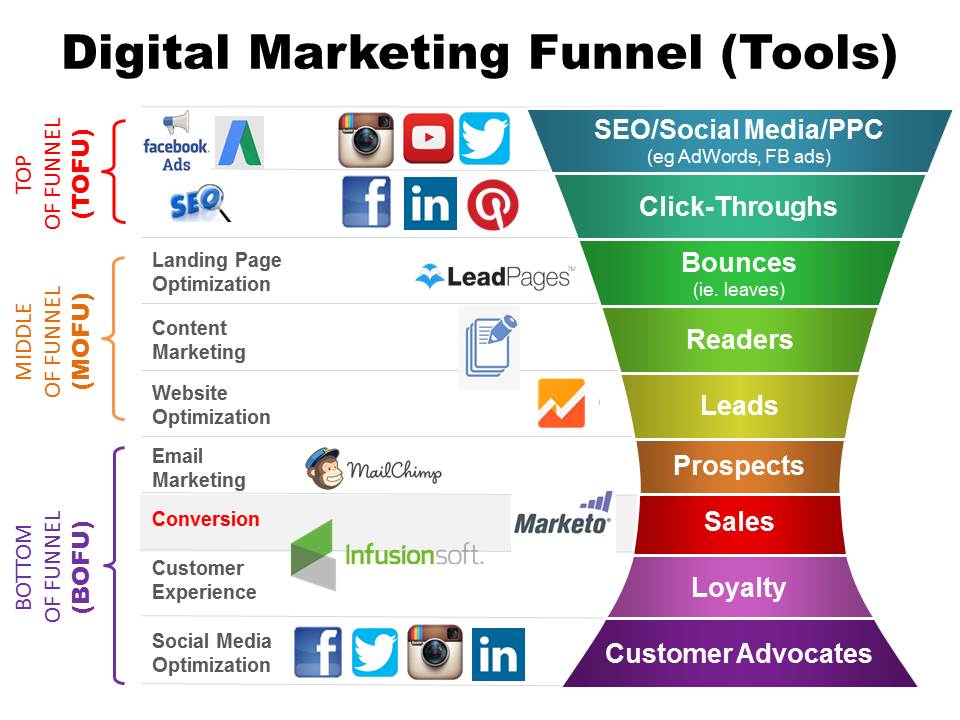AIDA (Attention, Interest, Desire, Action) is no longer serving us as well as she did.
At least according to Avinash Kaushik, renowned Digital Marketing Evangelist of Google.
Thanks to a podcast episode on Mitch Joel’s brilliant Six Pixels of Separation, I learned that marketing in the digital age should be focused on what customers are thinking in various stages of consideration rather than what companies desire them to do.
In other words, it’s all about them and not you!
This new spin on the marketing funnel can be boiled down to three simple stages of customer consideration: See, Think and Do.
1) See – all possible customers
The first and largest possible stage, the initial See stage encompasses all possible customers of a particular category.
Examples include the following:
- “All people who eat breakfasts”
- “All people who drive cars”
2) Think – customers with intent
A subset of the first, the Think stage is where people exhibit some degree of intent.
Back to our example, this would then be “all people who eat breakfasts who think that they need a different menu tomorrow.”
3) Do – ready to buy
The final stage of consideration, people in the Do stage are those who are actively seeking to purchase.
Using the same example earlier, this would then be “all people who eat breakfasts who think that they need a different menu tomorrow and are looking to buy something.”
We can represent this visually by the diagram from Avinash Kaushik below:

Courtesy of Occam’s Razor
With the See-Think-Do framework in mind, you should consider how content can be created, shaped and molded to attract audiences at all three stages of consideration.
As most companies are focused on the “Do” stage – ie, getting customers to buy a product or service – they often fail to resonate with potential customers who fall into the earlier stages of consideration. This can be a grave mistake and lead to multiple lost opportunities.
Modcloth – an exemplar of “See-Think-Do”
Avinash cites the example of Modcloth, and how its e-commerce website did a lot more than sell (see diagram below).

Courtesy of Occam’s Razor
If you’re in the “See” stage, you may be somebody who is just checking out what fashion trends are like this season. There are lots for you to experience on Modcloth’s website – a blog, reviews, photos, and sharing buttons.
If you’re in the more advanced “Think” stage, you can join their community to be alerted on fashion updates, get some tips from a ModStylist (why doesn’t any of our local retailers do this?), or create a wishlist.
Naturally, like all e-commerce websites, Modcloth has an easy way for you to “Do”, ie make the purchase by “Adding to Bag”.
Applying “See-Think-Do”
To apply Avinash’s “See-Think-Do” framework, consider how your content, advertising channels, and metrics can be tailored to suit different audiences at their stages of consideration in the customer journey.
Think about the social context in which your messages and ads appear and whether these will carry any weight with the audiences you’re trying to attract.
In other words, as humorously described by Avinash below…
“No more running social ads with Do stage messages – it simply does not work. No more Product-centric pimpy ads in the See stage. No more BUY NOOOOOWWWWW ads on YouTube.” – Avinash Kaushik
Integrating digital marketing and measurement strategies as well as possible metrics/KPIs, the “See-Think-Act” framework can then be visualised below:

Courtesy of Occam’s Razor
Mapping “See-Think-Do” to the Marketing Funnel
If you think carefully about the “See-Think-Do” framework, you’ll notice that it has strong parallels with the digital marketing funnel below.
Customers that are at the “See” stage are those at the Top Of The FUnnel (TOFU). They are visitors and browsers who may have stumbled across your website by accident or intent.
Those that are at the “Think” stage would be in the Middle Of The FUnnel (MOFU). At this point, they have an intent to purchase, but are still gathering information and doing their research.
Finally, your prospects at the “Do” stage are ready to buy. At the BOttom of the FUnnel (BOFU), they are probably all ready to whip out their credit cards or wallets if you give them the right reasons to do so.
I love the elegance of the “See-Think-Do” online marketing framework.
It feels intuitively right, and provides a more logical way in which to pin one’s various marketing, content creation, and advertising strategies.
One size definitely does not fit all – not least in the digital world – and it makes sense for us to target a broader spectrum of potential consumers at various stages of consideration rather than aim for the very narrow slice of “ready to buy” customers.
Are there ways for us to apply these in our content marketing strategies? Do share your ideas below.

